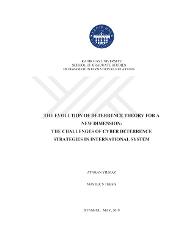| dc.description.abstract | States that have become the main actors of the international system after the Treaty of Westphalia; have seen cyberspace as a new field to carry out their traditional policies in addition to land, sea, air, and space. However, unlike other dimensions, since cyberspace is human-made and its design philosophy attaches importance to rapid and anonymous information sharing at low cost among parties rather than security; states face several non-traditional problems such as attribution problem, abundance of non-state actors that can challenge the state, and the asymmetric relations between states. Therefore, the states in which Information and Communication Technologies (ICT) are widely used, critical infrastructures are more integrated with ICT and has more intellectual properties; have started to seek security strategies to prevent cyber-attacks by adversaries. As a result of this seeking, since it is a prominent strategy in international politics during the Cold War period, the applicability of deterrence strategy has begun to be discussed. In this direction, while this thesis examining the applicability of classical deterrence theory in cyberspace, also addressing the obstacles to the implementation of cyber deterrence and possible ways to acquire successful cyber deterrence. Thus, firstly the main assumptions, necessary prerequisites, major and alternative strategies of cyber deterrence are discussed by looking at classical deterrence theory. Then, by classifying cyber threats and the materialization of threats, cyber-attacks, the major obstacles to the successful cyber deterrence strategies will be illustrated. Besides, by analyzing 260 cyber-attacks through six categories as time, victim, offender, attack type, target, and response; practices are going to be tested the theory. In this framework, since a cyber deterrence strategy that uses only cyber tools fails to prevent all cyber-attacks; by discussing the possibility of a restricted and hybrid cyber deterrence strategy that includes political, economic, military and diplomatic instruments, this study will be concluded. | en_US |
| dc.description.abstract | Vestfalya Antlaşması sonrasında uluslararası sistemin başat aktörleri haline gelen devletler siber uzayı
kara, deniz, hava ve uzaya ek olarak geleneksel politikalarını gerçekleştirecekleri yeni bir alan
görmektedirler. Fakat diğer boyutların aksine siber uzay insan yapımı olduğu ve tasarım felsefesi
güvenlikten daha ziyade taraflar arasında düşük maliyetle hızlı ve anonim bilgi paylaşımına önem
verdiği için devletler; tespit/isnat, çok fazla devlet dışı aktörlerin devlete meydan okuyabilmesi ve
devletler arasındaki asimetrik ilişkinin olması gibi geleneksel olmayan bir dizi sorunla
karşılaşmaktadırlar. Bu nedenle, özellikle kritik alt yapıların bilgi ve iletişim teknolojileriyle (ICT) daha
entegre olduğu, ICT’lerin daha yaygın olarak kullanıldığı ve fikri mülkiyete daha fazla sahip olan
ülkelerde; diğer devletlerden ve devlet dışı aktörlerden gelebilecek siber saldırıları engellemek için
güvenlik stratejileri arayışına girilmiştir. Bu arayışın bir sonucu olarak ise özellikle Soğuk Savaş
döneminde uluslararası politikada oldukça ön planda yer alan caydırıcılık teorisinin siber uzaydaki
uygulanabilirliği tartışılmaya başlanmıştır. Bu doğrultuda bu tez çalışması geleneksel caydırıcılık
teorisinin siber uzayda uygulanabilirliğini sorgularken aynı zamanda bu teorinin siber uzayda
uygulanmasının önündeki engelleri araştırmakta ve siber uzay için nasıl bir caydırıcılık stratejisinin
kurgulanabileceğini tartışmaktadır. Bunun için ilk olarak klasik caydırıcılık teorisinden yola çıkarak
siber caydırıcılığın temel varsayımları, gerekli ön koşulları, temel ve alternatif stratejileri ele alınırken,
ikinci olarak siber uzaydaki tehditler ve tehditlerin gerçekleşmesiyle ortaya çıkan siber saldırılar
sınıflandırılarak siber caydırıcılığın başarılı olmasının önündeki engellerin neler oldukları belirtilecektir.
Ayrıca önemli 260 siber saldırı zaman, saldırgan ve saldırılan devlet, saldırı türü, hedef ve yanıt olmak
üzere altı başlık altında incelenerek teoriğin dışında pratikte de hangi sorunlarla karşılaşıldığı analiz
edilecektir. Bu çerçevede yalnızca siber araçlara başvuran bir siber caydırıcılık stratejisinin tüm siber
saldırıları engellemede başarısız olduğu gerçeğinden yola çıkarak politik, ekonomik, askeri ve
diplomatik araçları da içinde barındıran hibrit ve sınırlı bir siber caydırıcılık stratejisinin siber uzayda
başarılı olma olasılıkları tartışılarak çalışmaya son verilecektir. | en_US |
















